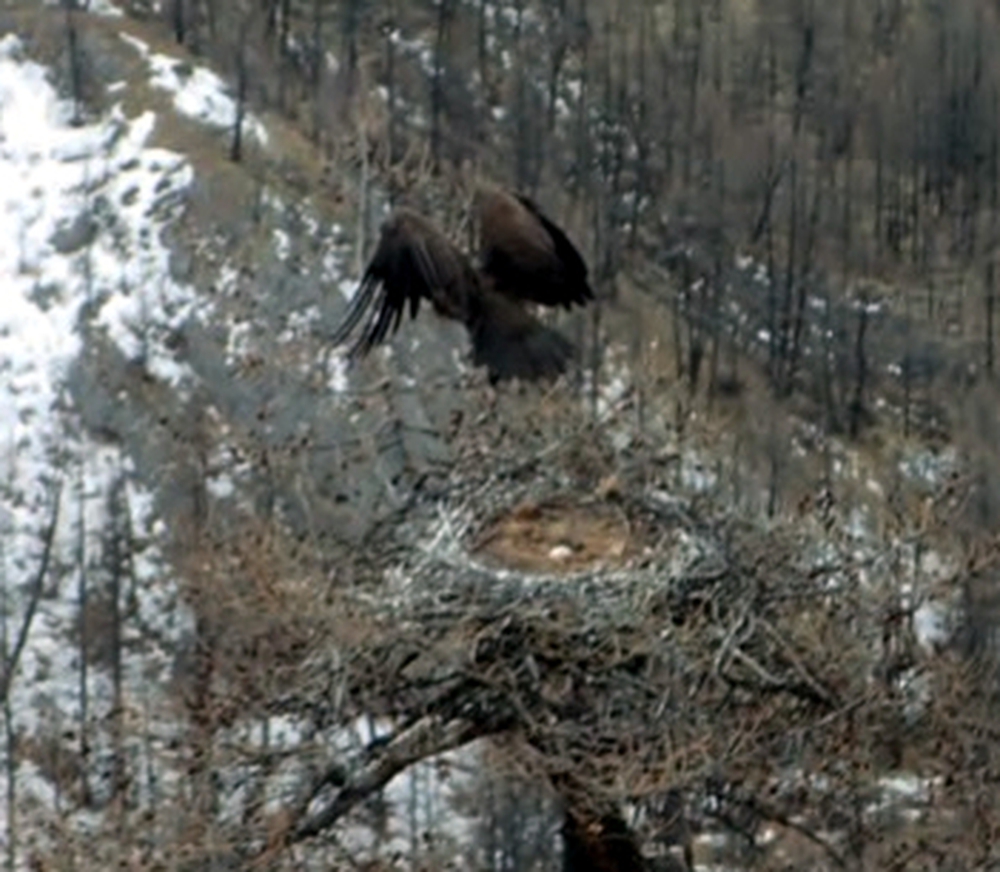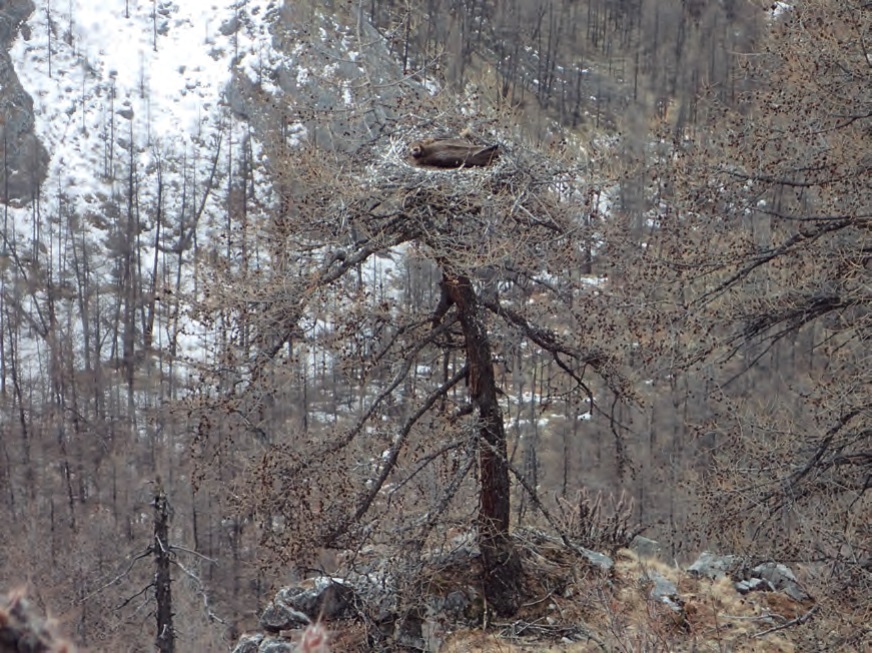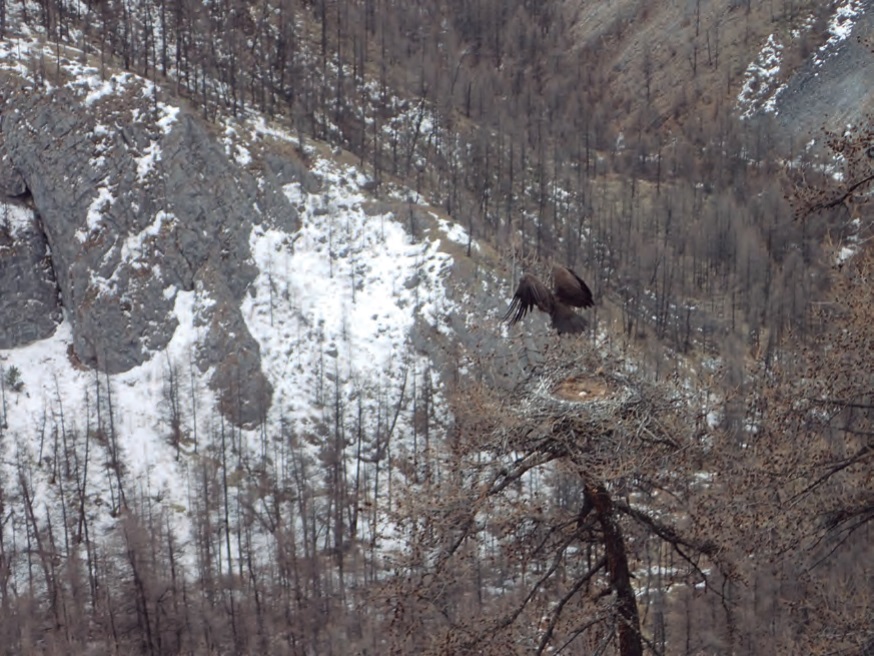
The last moment of the Vulture family idyll
For ten years now, I've taken little interest in ornithological literature, as preservation of Lake Baikal has become my absolute priority. But on occasion, I had to dig in the "ornithological sandbox" - and came across a publication, which greatly outraged me. “Black vulture encounters in Okinsky district (Republic of Buryatia) and in Slyudyanskiy district (Irkutsk region)” – Baikal Zoological Journal. – 2018. – V. 2 (23): 113–114. (by A. V. Osintsev, A. D. Botvinkin, and V. V. Popov).
It describes the discovery of the first black vulture nest for the Eastern Sayan: “April 8, 2018, about 13:00. The nest was observed and photographed from a distance of about 50 m. The bird was sitting firmly on the nest and flew off when one of the expedition members accidentally came close to a tree. There was one egg in the nest, clearly visible in the photographs. After the vulture took off, the speleologists quickly went behind the nearest rocks and made a survey of the slope, moving away from the nest. In doing so, the vulture circled high in the sky away from the nest.”
Here's the photos:


What's wrong? On April 8 at an altitude of 2.000 meters (and with cloudy weather), it must have been “deep-freezing”. The female was sitting on the nest “tightly” because leaving the clutch unheated in such conditions would be fatal. And a “quick exit” by humans in such a situation is of little help. A large bird of prey (a vulture, an eagle) disturbing a nest during incubation always soars to a high altitude and circles the skies for a long time before returning to the nest. This enforced absence may take 20-40 minutes or even more. At minus (say, 10 degrees) temperatures, the embryo in the egg may die without heating in about 15 minutes. The second clutch in April will not make vultures definitely (in March, at the beginning of incubation, there is some chance to do it). The only (most likely) pair of black vultures in the entire Eastern Sayan Mountains lost their only chick in 2018 due to what is officially called “research press”.
This disaster could have been avoided by adhering to the elementary rules obligatory for modern explorers. They include strictly avoiding inspecting the nests of large raptors during the incubation period. Walked into a nest by accident? Well, walk away carefully. And absolutely no need to take a photo of the female on the nest! “One of the expedition members accidentally came close to a tree.” What kind of accident is that? How could one not see the nest if it was discovered and photographed by another member of the expedition? This is simply “out of the question”.
It is clear that we speak about an expedition of speleologists for whom ornithological subtleties are unknown. But why should outrageous photos be published in a magazine which claims to be scientific? Many who read this publication do not even realise that it is a real environmental crime. Any note/article (as well as the scientific fact that there was only 1 egg in the nest) is not worth the death of a future chick of a very rare bird. All sane ornithologists adhere to the rule “better a white spot in science than in nature”. The editor of the magazine, when publishing the article and photo, dispensed with any explanation on this point. Worse, he is one (third in number) of its authors! I have not found the mentioned nest myself, probably it is related to the autumn meeting of the vulture on Baikal in the Slyudyanka area. Which is incomparably less interesting than the first known case of vulture nesting in East Sayan (that should be noted in the title!) and is poorly combined with it.
Alas for such a journal, and its editor.
In 2014 I did a publication - “On the ethics of wildlife photography”. The subject was the numerous photos of nests with chicks and clutches on the Baikal Nature website. There were a lot of offences, but in the next years the number of such photos has decreased sharply. And here is even more wild case, and it is connected with ornithologists! Are we going wilder and wilder?
Vitaly Ryabtsev
Original (in Russian): Struggle for Baikal, our “ecological Stalingrad”, Vitaly Ryabtsev's blog


In order to leave a comment, you need to log in!